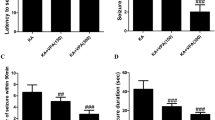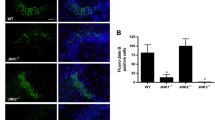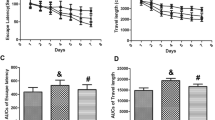Abstract
Injection of rats with kainic acid (KA), a non-N-methyl-d-aspartate (NMDA) type glutamate receptor agonist, induces recurrent (delayed) convulsive seizures and subsequently hippocampal neurodegeneration, which is reminiscent of human epilepsy. The protective effect of anti-epileptic drugs on seizure-induced neuronal injury is well known; however, molecular basis of this protective effect has not yet been elucidated. In this study, we investigated the effect and signaling mediators of voltage-gated Na+ channel blockers (Lamotrigine, Rufinamide, Oxcarbazepine, Valproic Acid, and Zonisamide) on KA-induced apoptosis in rat primary hippocampal neurons. Exposure of hippocampal neurons to 10 μM KA for 24 h caused significant increases in morphological and biochemical features of apoptosis, as determined by Wright staining and ApopTag assay, respectively. Analyses showed increases in expression and activity of cysteine proteases, production of reactive oxygen species (ROS), intracellular free [Ca2+], and Bax:Bcl-2 ratio during apoptosis. Cells exposed to KA for 15 min were then treated with Lamotrigine, Rufinamide, Oxcarbazepine, Valproic Acid, or Zonisamide. Post-treatment with one of these anti-epileptic drugs (500 nM) attenuated production of ROS and prevented apoptosis in hippocampal neurons. Lamotrigine, Rufinamide, and Oxcarbazepine appeared to be less protective when compared with Valproic Acid or Zonisamide. This difference may be due to blockade of T-type Ca2+ channels also by Valproic Acid and Zonisamide. Our findings thus suggest that the anti-epileptic drugs that block both Na+ channels and Ca2+ channels are significantly more effective than agents that block only Na+ channels for attenuating seizure-induced hippocampal neurodegeneration.





Similar content being viewed by others
References
Fuerst D, Shah J, Shah A et al (2003) Hippocampal sclerosis is a progressive disorder: a longitudinal volumetric MRI study. Ann Neurol 53:413–416
Leite JP, Bortolotto ZA, Cavalheiro EA (1990) Spontaneous recurrent seizures in rats: an experimental model of partial epilepsy. Neurosci Biobehav Rev 14:511–517
Scharfman HE (2007) The neurobiology of epilepsy. Curr Neurol Neurosci Rep 7:348–354
Williams PA, Hellier JL, White AM et al (2007) Development of spontaneous seizures after experimental status epilepticus: implications for understanding epileptogenesis. Epilepsia 48:157–163
Cannon SC (2002) Sodium channel gating: no margin for error. Neuron 34:853–854
Alekov AK, Rahman MM, Mitrovic N et al (2001) Enhanced inactivation and acceleration of activation of the sodium channel associated with epilepsy in man. Eur J Neurosci 13:2171–2176
Spampanato J, Escayg A, Meisler MH et al (2001) Functional effects of two voltage-gated sodium channel mutations that cause generalized epilepsy with febrile seizures plus type 2. J Neurosci 21:7481–7490
Catterall WA (1986) Molecular properties of voltage-sensitive sodium channels. Annu Rev Biochem 55:953–985
Mantegazza M, Curia G, Biagini G et al (2010) Voltage-gated sodium channels as therapeutic targets in epilepsy and other neurological disorders. Lancet Neurol 9:413–424
van Lookeren Campagne M, Lucassen PJ, Vermeulen JP et al (1995) NMDA and kainate induce internucleosomal DNA cleavage associated with both apoptotic and necrotic cell death in the neonatal rat brain. Eur J Neurosci 7:1627–1640
Urenjak J, Obrenovitch TP (1998) Neuroprotection–rationale for pharmacological modulation of Na+-channels. Amino Acids 14:151–158
Kim DH, Yoon BH, Jung WY et al (2010) Sinapic acid attenuates kainic acid-induced hippocampal neuronal damage in mice. Neuropharmacology 59:20–30
Ben-Ari Y, Cossart R (2000) Kainate, a double agent that generates seizures: two decades of progress. Trends Neurosci 23:580–587
Cavalheiro EA, Fernandes MJ, Turski L et al (1994) Spontaneous recurrent seizures in rats: amino acid and monoamine determination in the hippocampus. Epilepsia 35:01–11
Bi X, Chang V, Siman R et al (1996) Regional distribution and time-course of calpain activation following kainate-induced seizure activity in adult rat brain. Brain Res 726:98–108
Araújo IM, Ambrósio AF, Leal EC et al (2003) Neuronal nitric oxide synthase proteolysis limits the involvement of nitric oxide in kainate-induced neurotoxicity in hippocampal neurons. J Neurochem 85:791–800
Stucki BL, Matzelle DD, Ray SK, et al. (2004) Upregulation of calpain in neuronal apoptosis in kainic acid induced seizures in rats, ASN Annual Meeting, August 14-19, DP1-01
Lee SH, Chun W, Kong PJ et al (2006) Sustained activation of Akt by melatonin contributes to the protection against kainic acid-induced neuronal death in hippocampus. J Pineal Res 40:79–85
Nunez J (2008) Primary culture of hippocampal neurons from P0 newborn rats. J Vis Exp 19:895
Sunanda RaoBS, Raju TR (1998) Corticosterone attenuates zinc-induced neurotoxicity in primary hippocampal cultures. Brain Res 791:295–298
Das A, McDowell M, Pava MJ et al (2010) The inhibition of apoptosis by melatonin in VSC4.1 motoneurons exposed to oxidative stress, glutamate excitotoxicity, or TNF-α toxicity involves membrane melatonin receptors. J Pineal Res 48:157–169
Das A, Sribnick EA, Wingrave JM et al (2005) Calpain activation in apoptosis of ventral spinal cord 4.1 (VSC4.1) motoneurons exposed to glutamate: calpain inhibition provides functional neuroprotection. J Neurosci Res 81:551–562
Waters SL, Sarang SS, Wang KK et al (1997) Calpains mediate calcium and chloride influx during the late phase of cell injury. J Pharmacol Exp Ther 283:1177–1184
Devi PU, Manocha A, Vohora D (2008) Seizures, antiepileptics, antioxidants and oxidative stress: an insight for researchers. Expert Opin Pharmacother 9:3169–3177
Enns GM (2008) Neurologic damage and neurocognitive dysfunction in urea cycle disorders. Semin Pediatr Neurol 15:132–139
Henshall DC, Araki T, Schindler CK et al (2002) Activation of Bcl-2-associated death protein and counter-response of Akt within cell populations during seizure-induced neuronal death. J Neurosci 22:8458–8465
Giusti P, Franceschini D, Petrone M et al (1996) In vitro and in vivo protection against kainate-induced excitotoxicity by melatonin. J Pineal Res 20:226–231
Tan DX, Manchester LC, Reiter RJ et al (1998) Melatonin protects hippocampal neurons in vivo against kainic acid-induced damage in mice. J Neurosci Res 54:382–389
Gao L (2010) An update on peptide drugs for voltage-gated calcium channels. Recent Pat CNS Drug Discov 5:14–22
Joëls M (2009) Stress, the hippocampus, and epilepsy. Epilepsia 50:586–597
Bilsland J, Harper S (2002) Caspases and neuroprotection. Curr Opin Investig Drugs 3:1745–1752
Nagatomo I, Akasaki Y, Uchida M et al (2000) Effects of combined administration of zonisamide and valproic acid or phenytoin to nitric oxide production, monoamines and zonisamide concentrations in the brain of seizure-susceptible EL mice. Brain Res Bull 53:211–218
Acknowledgments
This paper was dedicated to honor Dr. Abel Lajtha, who had the foresight to establish this journal and significantly contributed new knowledge not only to basic neuroscience but also to medical neuroscience.
Author information
Authors and Affiliations
Corresponding author
Additional information
Special Issue: In Honor of Dr. Abel Lajtha.
Rights and permissions
About this article
Cite this article
Das, A., McDowell, M., O’Dell, C.M. et al. Post-Treatment with Voltage-Gated Na+ Channel Blocker Attenuates Kainic Acid-Induced Apoptosis in Rat Primary Hippocampal Neurons. Neurochem Res 35, 2175–2183 (2010). https://doi.org/10.1007/s11064-010-0321-1
Accepted:
Published:
Issue Date:
DOI: https://doi.org/10.1007/s11064-010-0321-1




